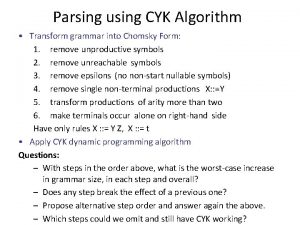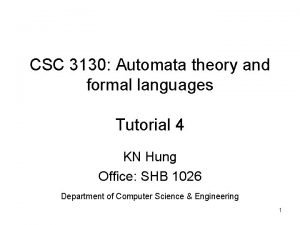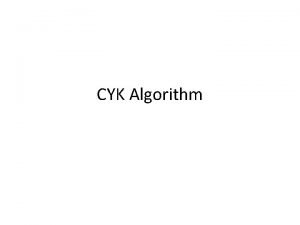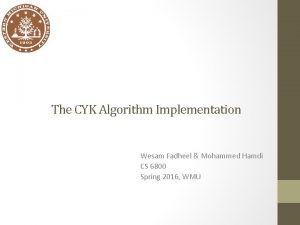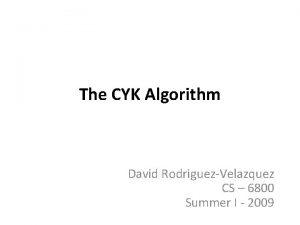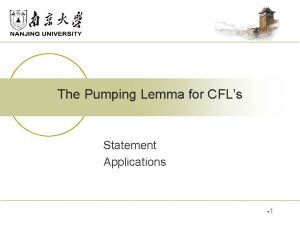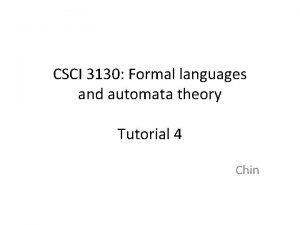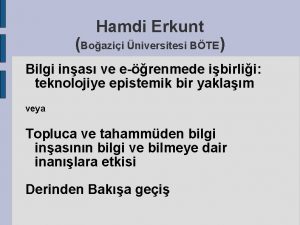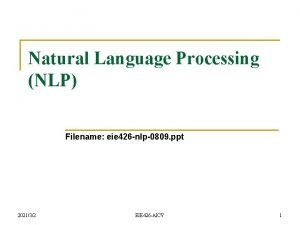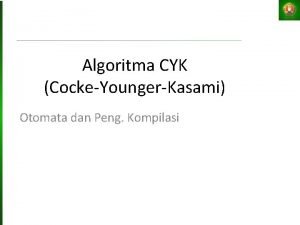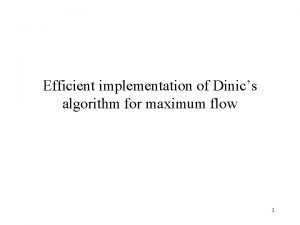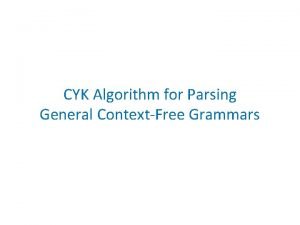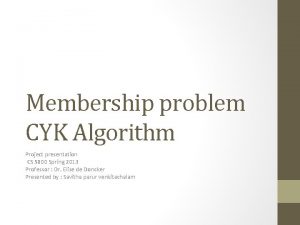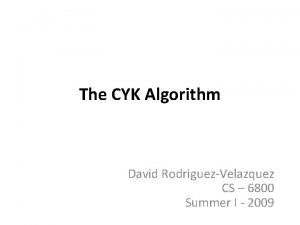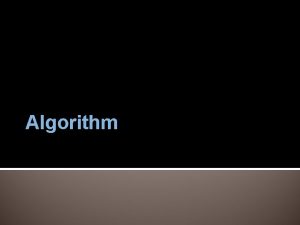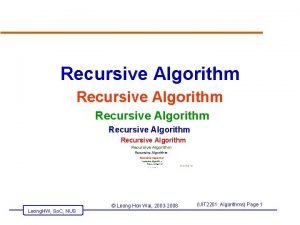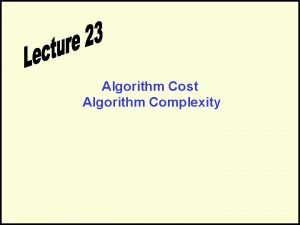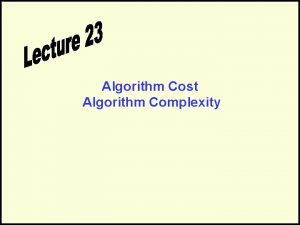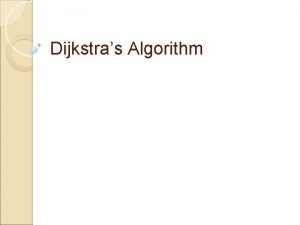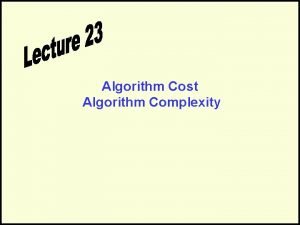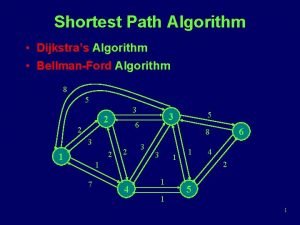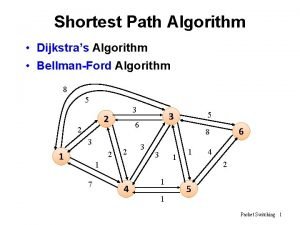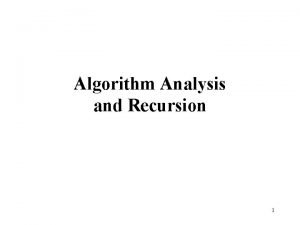The CYK Algorithm Implementation Wesam Fadheel Mohammed Hamdi






















- Slides: 22

The CYK Algorithm Implementation Wesam Fadheel & Mohammed Hamdi CS 6800 Spring 2016, WMU

Outline • • • CYK Algorithm. The basics of CYK Algorithm. The Chomsky Normal Form CNF. CYK Algorithm steps. How does the CYK Algorithm start? Build the Triangular Table & example 1. Build the Upper Diagonal Matrix Table & example 2. Notes. References.

The CYK Algorithm • It is called CYK or CKY Algorithm according to its inventors Cocke-Kasami-Younger. • It is a membership problem to determine weather the string (w) belongs to the grammar (G) or not.

The CYK Algorithm • It is a bottom-up parser that uses the nondeterministic way in backtracking to build the table. • Trace all rules and non terminal variables that derive the string ( if w L (G) ).

The basics of the CYK Algorithm • It works only with rules in Chomsky Normal Form CNF. • Dynamic Programming Approach in constructing the table. What are the basics of CYK Algorithm ?

The Chomsky Normal Form CNF • A context free grammar G=(V, , P, S) in which each rule must satisfy a set of conditions. • Each rule should be as one of the following forms : A BC A a S Where BC V – {S}

The CYK Algorithm steps G is a CNF grammar, w = • is a string. For j = 1 to n do : If G contains the rule X , then add X to T [ 1, j ]. • For i = 2 to n do : For j = 1 to n – i + 1 do : For k = 1 to i - 1 do : For each rule X YZ do : If Y T [ k, j ] and Z T [ i - k, j + k ], then : Insert X into [ i, j ]. • If T [ n, 1 ] then accept, else reject. State the CYK Algorithm steps.

How does the CYK Algorithm start? • Count the number of terminals in the given string to determine the dimension of the table. • Look for the terminals in the right side of the given CNF rules. • Start to build the table from the lower row.

1. Build the Triangular Table • In each cell in the lower row, assign the variables in the CNF rules that derive each given terminal in the string. • Continue to construct the other rows of the table by using the computed cells in the previous row. • The no. of rows = The no. of columns = length of the given string. • The last computed cell determines the answer.

The Triangular Table of string w, w = 5 http: //web. cs. ucdavis. edu/~rogaway/classes/120/winter 12/CYK. pdf

The Triangular Table The computation process of the Triangular Table http: //web. cs. ucdavis. edu/~rogaway/classes/120/winter 12/CYK. pdf

Example 1 : G is a CNF grammar : S TA | BA | AB | b A AC | a T AB B b C c w = acbac Does w belong to G ? w = abacc Construct the Triangular Table to determine weather w belongs to G or not

Example 1 : Does w belong to G ? Yes There is a start symbol S in the last computed cell , where n = 5. = { S } So acbac L (G)

2. Build the Upper Diagonal Matrix Table • In each cell in the lower diagonal, assign the variables in the CNF rules that derive each given terminal in the string. • Continue to construct the other diagonals of the table by using the computed cells in the previous diagonal. • The no. of rows = The no. of columns = length of the given string. • The last computed cell determines the answer.

The Upper Diagonal Matrix Table of string w, w = 5

The Upper Diagonal Matrix Table The computation process of the Upper Diagonal Matrix Table

Example 2 : G is a CNF grammar : S AB | BC A BA | a B CC | b C AB | a w = abaaa Does w belong to G ? w = ababa Construct the Upper Diagonal Matrix Table to determine weather w belongs to G or not

Example 2 : Does w belong to G ? No There is no start symbol S in the last computed cell , where n = 5. = { B } So abaaa L (G)

Notes : • CYK algorithm computes all cells and construct the table for any given string, so w L (G) S . • The execution time for the CYK algorithm is O ( ).

Example 3 : G is a CNF grammar : S CB | AA | BD A AC | BB | a B BC | DA | b C CB | c D d w = adabc Does w belong to G ?

The References : 1. Rich E. . (2008). Automata, Computability & Complexity: Theory and Application. 2. Rodriguez D. , Velazquez. (2009). The CYK Algorithm. Retrieved from : http: //web. cs. ucdavis. edu/~rogaway/classes/120/winter 12/CYK. pdf 3. Sudkamp T. . (1997). Languages and Machines: An Introduction to Theory of Computer Science. 2 nd Edition.

Thank you
 Palliative xrt definition
Palliative xrt definition Control of particulate matter
Control of particulate matter Advantages and disadvantages of train
Advantages and disadvantages of train Cyk algorithm
Cyk algorithm Cyk algorithm
Cyk algorithm Formal languages and automata theory tutorial
Formal languages and automata theory tutorial Cyk algorithm
Cyk algorithm Cyk algo
Cyk algo Cyk algorithm java
Cyk algorithm java Automata theory tutorial
Automata theory tutorial Cyk algorithm example
Cyk algorithm example Pumping lemma for cfls
Pumping lemma for cfls Csci 3130
Csci 3130 Dr sonia hamdi
Dr sonia hamdi Mokhtar hamdi
Mokhtar hamdi Hamdi erkunt
Hamdi erkunt Discourse integration in nlp
Discourse integration in nlp Algoritma cyk
Algoritma cyk Dinics
Dinics Ricart agrawala algorithm implementation
Ricart agrawala algorithm implementation Epcardium
Epcardium Dr samah mohammed
Dr samah mohammed Dr reshma mohammed
Dr reshma mohammed



